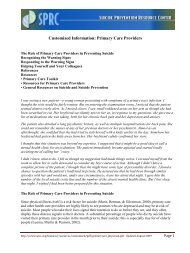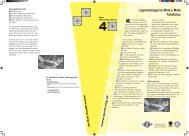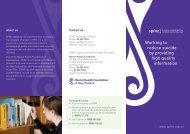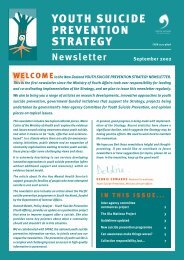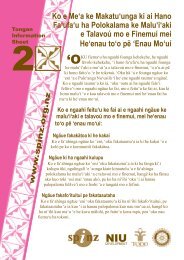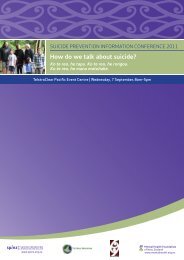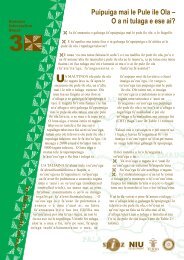A background document to support Kia Piki Te Ora O Te ... - SPINZ
A background document to support Kia Piki Te Ora O Te ... - SPINZ
A background document to support Kia Piki Te Ora O Te ... - SPINZ
Create successful ePaper yourself
Turn your PDF publications into a flip-book with our unique Google optimized e-Paper software.
Considering the impact of an individual’s grief, what happens in situations where whole groups of family<br />
members are obliterated through circumstances outside of their control? This has been the his<strong>to</strong>rical<br />
experience of indigenous peoples. How do individuals cope with the extent of that grief and when do Mäori<br />
collectively grieve for all the lives that were unjustly lost <strong>to</strong> his<strong>to</strong>rical circumstances that they could not<br />
prevent? Is there a spiritual and psychological impact that consumes Mäori and other indigenous populations,<br />
that is ever present in the contemporary realities of Mäori and that lies just below the surface of Mäori and<br />
indigenous consciousness?<br />
In a paper on the impact of land confiscation in Tainui, Mahuta identified that raupatu (land confiscation)<br />
has had a profound psychological impact on the people of Tainui. 80 Land confiscation and genocide have<br />
also had a devastating impact on generations of Mäori youth in Taranaki who are now trying <strong>to</strong> res<strong>to</strong>re<br />
whakapapa where whole families and generations have been erased from his<strong>to</strong>ry as if they never existed.<br />
How do contemporary Mäori cope with the extent of Mäori grief?<br />
ACCULTURATIVE STRESS<br />
Acculturation results from two cultures coming in<strong>to</strong> contact, with subsequent changes in the original cultural<br />
patterns of either or both groups. Assimilation or the forcing of one culture in<strong>to</strong> another occurs during the<br />
process of acculturation.<br />
Acculturative stress is defined by Berry as:<br />
... one kind of stress, that in which the stressors are identified as having their source in the process of<br />
acculturation. In addition, there is often a particular set of stress behaviours that occur during acculturation<br />
such as lowered mental health status (especially confusion, anxiety, depression), feelings of marginality<br />
and alienation, heightened psychosomatic symp<strong>to</strong>ms level and identity confusion.<br />
Acculturation continues <strong>to</strong> be a process that impacts on contemporary Mäori. The extent <strong>to</strong> which Mäori<br />
suffer from stress-related illness and diseases may be relevant <strong>to</strong> the ongoing influence and transmission of<br />
acculturative stress over generations.<br />
INSTITUTIONAL, STRUCTURAL AND PERSONAL RACISM<br />
I see these girls coming in <strong>to</strong> high school with their selves battered and bruised after eight years in the<br />
system... They have little confidence. Their behaviour often reflects their inner pain and confusion. And<br />
all the school does is <strong>to</strong> yell at them, <strong>to</strong> punish them, <strong>to</strong> expel them... The frustrations of being a Mäori<br />
language teacher are essentially summed up in the feeling that the education system has invited you <strong>to</strong><br />
be a mourner at the tangihanga (funeral) of your culture, your language and yourself. 81<br />
The link between racism and the marginalisation of Mäori cultural values and Mäori individuals has been<br />
identified. 82 The continued failure of Mäori in education confirms that the education system is not a place<br />
that effectively serves many young Mäori.<br />
The life chances of Mäori are reduced significantly through educational failure. The education system in New<br />
Zealand continues <strong>to</strong> embrace mainstream New Zealand values and perceptions of valid knowledge. Mäori<br />
content and process is generally marginalised within this schooling process. 83<br />
A REVIEW OF EVIDENCE: KIA PIKI TE ORA O TE TAITAMARIKI – THE NEW ZEALAND YOUTH SUICIDE PREVENTION STRATEGY<br />
In practical terms, this places Mäori students at significant risk. Risk from a process that batters self-esteem<br />
and confirms a sense of failure and worthlessness for many Mäori youth, risk from a process that confirms<br />
that the uniqueness that they bring with them as Mäori has no place in mainstream education in New<br />
Zealand, risk from a process that confirms indirectly – and at the most fundamental of levels – that being<br />
Mäori is the same as being a failure.<br />
PAGE 17



